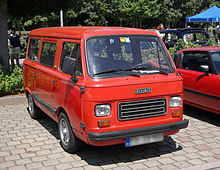Fiat 900T
- Fiat 900E
- Fiat Citivan (United Kingdom)
- Zastava 900 (Yugoslavia)
Fiat 1100T
The Fiat 900T was a small van produced by the Italian automobile manufacturer Fiat between 1976 and 1985, replacing the similar Fiat 850T.[1] It was first presented in November 1976, at the Turin Show.[2] In the UK, it was sold as the Fiat Citivan.
While using many of the 850T's body panels, the roof was taller and the front clip was also redesigned. The taller roof also allowed for a larger front windshield, increasing in height by 6 cm (2.4 in).[2] The new front had rectangular headlamps and featured a new grille as well. The 900T was equipped with 12-inch wheels borrowed from the Fiat 126, albeit fitted with wider rims. The bumpers were also redesigned as was the interior, which sported the steering wheel from the contemporary Fiat 127 Special.[2] The 900T was available in a number of variants, including a seven-seat minibus (Pulmino in Italy), and the Shango camper van; British buyers could choose between the Amigo and Pandora campers. Typical bodystyles included a panel van, high-roof panel van, promiscuo (glazed van with rear seating), and the minibus. The van and promiscuo could also be had with a sliding side door or an additional rear driver's side door.[2]
Specifications


The 900T was powered by a rear-mounted, four-cylinder 903 cc petrol engine, shared with the Fiat 127. In the 900T, it produced 35 bhp (26 kW; 35 PS) at 4,500 rpm and 44.84 lb⋅ft (61 N⋅m) at 3,300 rpm.[3] The 850T's dynamo was replaced by a more modern alternator. The 900T has a small turning circle of 9 metres (29 ft 6.5 in).
The van was originally fitted with drum brakes all around. The standard van's luggage compartment could hold 2,650 L (93.6 cu ft).
900E (1980)
In 1980, the 900T was updated and renamed the 900E. The wheels were changed to units borrowed from the Fiat 128, new black bumpers were larger and more square, the taillights were now rectangular units from the Fiat 238/242, while front disc brakes were fitted and the interior revised using many parts from the recently updated Fiat 127 (second series).
Models
The 900E minibus was discontinued without a direct successor in 1981. Fiat kept producing the cargo versions until 1986, by which time Japanese microvans and trucks had taken over this market segment. Production continued at Zastava's Kragujevac plant until 1989–1990. Zastava's 900 was available as a van (AK), pickup (F), double-cab pickup (AF), or minibus (AL).
Fiat didn't produce pickups at the time so third party coach builders, including Coriasco and Fissore, would purchase 900T vans from the Fiat factory and convert them into pickups (and campers). These companies cut away the rear body and added panels as needed to complete the conversion, and then re-sprayed the car in the original color. Coriasco and Fissore stamped the rear of the body with their own vehicle identification number to the right of the original Fiat VIN, the numbers then being combined into a longer vehicle identification number on the title. The pickup version was very similar to the Volkswagen Combi, with a raised rear bed, removable bed walls, and large storage area accessible from either side underneath.
References
- ^ "HISTORY: Working alongside professionals for over 100 years". Fiat. Fiat Professional UK. 20 August 2013. Retrieved 20 August 2013.
- ^ a b c d Strambaci, Fernando, ed. (1976-11-01). "La Fiat 126 ora anche nelle versioni Personal" (PDF). l'Unità (in Italian). p. 11. Archived from the original (PDF) on 2023-06-05.
- ^ Citivan leaflet. Fiat UK. June 1978. Archived from the original on 23 March 2014. Retrieved 20 August 2013.

- v
- t
- e
| Predecessor |
| ||||
|---|---|---|---|---|---|
| Parent |
| ||||
| Subsidiaries and divisions |
|

| Cars | |
|---|---|
| Crossovers/SUVs | |
| Vans |
|
| Pickup trucks | |
| Abarth |
|
(List)
| 1980–2019 |
|
|---|---|
| 1950–1979 | |
| 1920–1949 |
|
| 1899–1919 | |
| LCVs |
- 130 HP
- 28-40 HP
- Mephistofeles
- S74
- S76 Record
- Patriarca 1100
 Category
Category Commons
Commons












